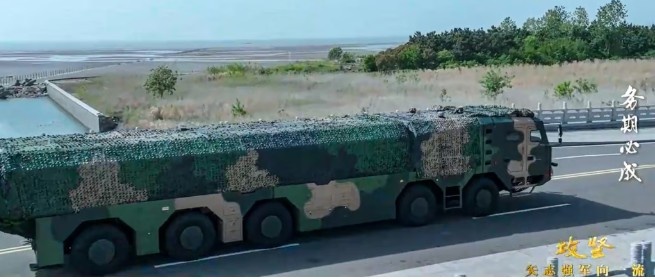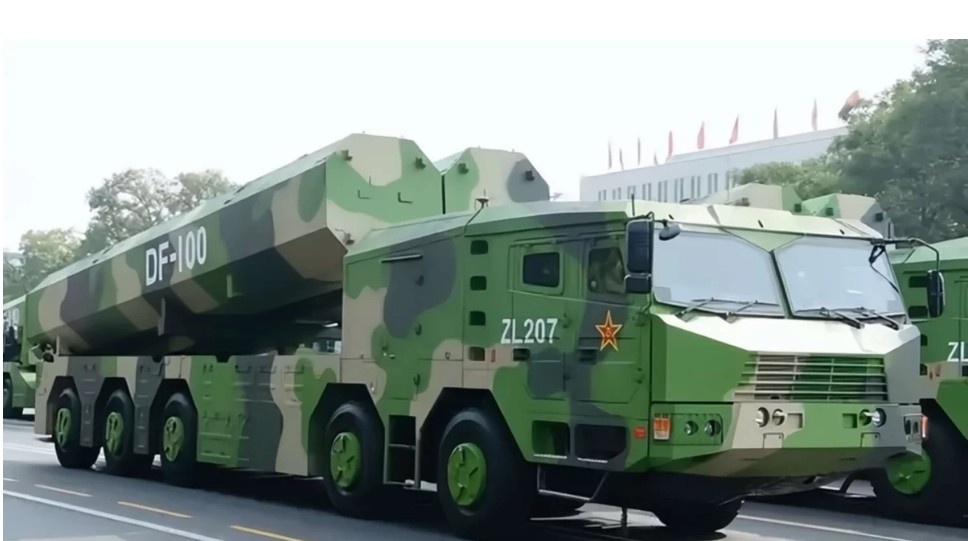“Supersonic Death”! China Flashes Very Rare Footage Of Its 4000 KM Carrier-Killer Cruise Missile, DF-100

China is known to guard the secrets and capabilities of its weapon systems closely. However, diverging from the norm, Beijing has released a rare video of its mysterious DF-100 supersonic missile, shedding new light on the capabilities and specifications of its frontline missile.
Notably, the two-minute segment released last week as part of the final episode of a documentary on the People’s Liberation Army (PLA) marked only the second time that China has released footage of the cruise missile since its high-profile debut in 2019.
The significance of this new footage can be gauged from the fact that the last time China released footage of this missile, it was only two seconds long, and the missile has been blurred on its launch vehicle, making it impossible to analyze the technical specifications and the operating model.
The last footage was released in 2019 and was deleted from official channels just hours later.
The state media in China, including China News Service and accounts affiliated with Xinhua News Service themselves, reported the event as a rarity.
These media platforms shared the footage under the headline “Rare public release of DF-100 cruise missile launch video,” and also confirmed the model of the missile.

The latest footage is nearly two minutes long. The video footage, released on China Central Television (CCTV), is part of the fifth and final episode of a People’s Liberation Army documentary.
The documentary is part of the commemorations for the PLA’s 98th anniversary. It also precedes a large-scale military parade in Beijing on September 3 to celebrate the 80th anniversary of China’s victory over Japan in the Second World War and the global victory against fascism.
It is anticipated that China could also unveil some new weapon systems during or in the run-up to the military parade on September 3.
The Footage
The two-minute-long footage showed a PLA Rocket Force brigade conducting a cable communications exercise that began before dawn and included a scenario in which enemy forces attempted full-spectrum jamming, requiring the unit to establish a wired communications link rapidly before launch, the Hong Kong-based South China Morning Post (SCMP) reported.
“We are on standby for long periods, “Brigade deputy commander Lieutenant Colonel Zhang Guodong told CCTV, adding that “sometimes we can’t get a solid night’s sleep for days.”
“Our targets are mobile, and so are our positions,” Zhang said.
In the footage, the missile is shown to be launched from an urban setting, a departure from previous launch videos where the missile was launched from desert settings.
According to analysts, the launch from an urban setting points to the flexibility of DF-100 launch platforms.
Yun Sun, a senior fellow and director of the China programme at the Stimson Centre, said the urban backdrop “is evidently aimed at illustrating the flexibility and mobility of DF-100’s launching capability. If it can be launched close to urban areas, it will be more difficult for adversaries to locate, identify, target, and destroy it.”
Retired US Army lieutenant colonel Dennis Blasko said the site resembled the PLA’s 656th Brigade under Base 65, citing a US Air Force think tank report and his own review of satellite imagery that showed distinctive orange sheds and a training hangar on the outskirts of Laiwu in Shandong province.
“Looking at Google Earth imagery of the Yangfang parade training area in Beijing, I’m pretty sure we’ll see the DF-100 again soon in the September parade,” Blasko, a former US defense attaché in Beijing and Hong Kong with 23 years of service as a military intelligence officer, told the SCMP.
The DF-100: China’s Anti-Ship Cruise Missile
The DF-100 made its debut in 2019 during the 70th national anniversary parade. However, initially, there was considerable confusion over its name. The presenter referred to the missile as CJ-100, despite the “DF-100” markings on its launch canister.
“Here comes the CJ-100 cruise missile formation…the latest in the CJ series. The hypersonic weapon features high precision and long-range strike capability, as well as fast response,” the presenter had said in 2019.
In China, the DF or Dong Feng prefix is generally reserved for ballistic missiles, whereas the CF or Chang Jian prefix is reserved for land-attack cruise missiles.
The missile also made an appearance at the 2024 Zhuhai air show, where its specifications were made public: a range of 3,000-4,000km (1,865-2,485 miles), a Mach 4 cruising speed, strong penetration capabilities, high strike accuracy, and a rapid reaction time.

Notably, the range of 4,000 km will cover the entire First Island Chain around China, a string of strategic archipelagos surrounding mainland China that includes Japan, the Ryukyu Islands, Taiwan, the northern Philippines, and Borneo.
This concept is central to the US island chain strategy, which aims to contain the military expansion of China in the Indo-Pacific. The US also maintains many strategic military bases in the First Island Chain, such as Kadena Air Base on Okinawa, Yokosuka Naval Base, and Misawa Air Base in Japan.
The range of 4,000 km will also place most of the Second Island Chain within reach of the DF-100. The Second Island Chain also includes the US military base in Guam.
Thus, the supersonic cruise missile threatens key US military bases, aircraft carriers, and logistics hubs in the First and Second Island Chain and has the potential to challenge the US ability to project power to the West of the Second Island Chain.
The missile’s speed, range, and precision suggest applications in China’s Anti-Access/Area Denial (A2/AD) strategy.
Furthermore, the missile can be launched from dual platforms. It can be launched from land-based vehicles such as a 10×10 transporter erector launcher (TEL) vehicle, as well as from the H-6N bomber. Notably, when launched from the H-6N bomber, its range could be extended to over 6,000 km.
The system is capable of engaging targets such as land-based facilities, reinforced structures, underground bunkers, and large naval vessels such as aircraft carriers. Furthermore, the missile could carry both conventional and nuclear warheads.
The missile’s significance in China’s strategic calculus can be imagined from the fact that Beijing maintains more secrecy around the DF-100 than it maintains around platforms such as fifth-generation stealth fighters like the J-20 and J-35A.
- Questions and Answers
- Opinion
- Motivational and Inspiring Story
- Technology
- Live and Let live
- Focus
- Geopolitics
- Military-Arms/Equipment
- Segurança
- Economy
- Beasts of Nations
- Machine Tools-The “Mother Industry”
- Art
- Causes
- Crafts
- Dance
- Drinks
- Film/Movie
- Fitness
- Food
- Jogos
- Gardening
- Health
- Início
- Literature
- Music
- Networking
- Outro
- Party
- Religion
- Shopping
- Sports
- Theater
- Health and Wellness
- News
- Culture

